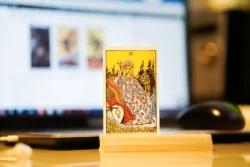Valentine’s Day occurs every February 14. Across the United States around the world, lovers and loved ones exchange candy, flowers, cards, and gifts, all in name of the mostly unknown story of St. Valentine. Who is this saint and how did these modern traditions evolve? The origin of the day’s importance begins with the ancient Roman ritual of Lupercalia that welcomed spring every year. The common practice of card-giving started during the Victorian period in England.
Saint Valentine
At least three individual saints called Valentine are recognized by the Catholic Church, all of whom were martyred. Valentine, according to stories, was a priest who served in Rome around the third century. Emperor Claudius II forbade marriage for young men because he believed that lone men made better soldiers than those with wives and families. Valentine disobeyed Claudius and continued to perform covert marriages for young couples. Claudius ordered Valentine’s execution after his acts were exposed.
Still, others insist that it was Saint Valentine of Terni, a bishop, who was the true namesake of the holiday. Claudius II also beheaded him outside of Rome. According to some accounts, Valentine was slain for attempting to assist Christians in escaping the harsh Roman jails, where they were frequently beaten and tormented.
Next after this publicity
According to historical narratives, an imprisoned Valentine sent the first “valentine” greeting after falling in love with a young girl who visited him during his confinement. He is said to have written her a letter inscribed “From your Valentine” before his death, an idiom that is still used today.
Although the truth underlying the Valentine legends is hazy, all of the stories emphasize Valentine’s attractiveness as a sympathetic, heroic, and amorous person. Valentine would become one of the most popular saints in England and France by the Middle Ages, likely as a result of his reputation.
Valentine’s Day, A Pagan Festival
While some believe that Valentine’s Day is celebrated in the middle of February to commemorate the anniversary of Valentine’s death or burial around 270 AD, others believe that the Christian church chose the middle of February to “Christianize” the pagan Lupercalia celebration. Lupercalia was a fertility festival devoted to Faunus, the Roman god of agriculture, as well as the Roman founders Romulus and Remus, and was held on the ides of February, or February 15.
Members of the Luperci, a Roman priestly order, would congregate at a sacred cave where the children Romulus and Remus, the founders of Rome, were said to have been cared for by a she-wolf, to begin the festival. A goat would be sacrificed for fertility, and a dog would be sacrificed for purification. They would then peel the goat’s hide into strips, immerse them in the sacrificial blood, and slap women with the goat hide.
Rather than being afraid of the contact of the skins, Roman women welcomed it because it was thought to make them more fertile. According to folklore, all of the city’s young women would gather on that day and place their names in a large urn. Each of the city’s bachelors would choose a name and be partnered with his preferred wife for the year. These encounters frequently resulted in marriage.
Next after this publicity
Becoming the Day of Romance
Lupercalia survived the early Christian era but was forbidden towards the end of the fifth century, when Pope Gelasius designated February 14th as St. Valentine’s Day, judging the 15th as “un-Christian”. However, it was not until much later that the day became permanently linked to love. During the Middle Ages, it was widely thought, in France and England, that February 14 marked the start of bird mating season, adding to the notion that Valentine’s Day should be a day of passion.
In his 1375 poem “Parliament of Foules,” English author Geoffrey Chaucer was the first to mention St. Valentine’s Day as a day of love, writing, “For this was sent on Seynt Valentyne’s day / Whan every foul cometh ther to choose his mate.”
Valentine greetings were popular as far back as the Middle Ages, though written Valentine’s did not begin to appear until after 1400. The oldest known valentine still in existence today was a poem written in 1415 by Charles, Duke of Orleans, to his wife while he was imprisoned in the Tower of London. Several years later, it is believed that King Henry V hired a writer named John Lydgate to compose a valentine note to Catherine of Valois.
Valentine’s Day Cards, Candy, and Flowers
Cards
Valentine’s Day is observed in Canada, Mexico, the United Kingdom, France, and Australia, in addition to the United States. Around the 17th century, Valentine’s Day became popular in the United Kingdom.
Friends and lovers of all social groups exchanged tiny mementos of affection or handwritten notes by the middle of the 18th century, and thanks to advances in printing technology, printed cards began to supplant written letters by 1900. In a time when direct expressing of one’s feelings was discouraged, ready-made cards were a convenient way for people to express their views. A rise in the popularity of mailing Valentine’s Day messages was also aided by lower postage charges.
In the early 1700s, Americans began sharing hand-made valentines. Esther A. Howland started selling the first mass-produced valentines in America in the 1840s. Howland dubbed the “Mother of the Valentine,” created complex designs using actual lace, ribbons, and bright “scrap” images. The Greeting Card Association estimates that 145 million Valentine’s Day cards are sent each year, making it the second most popular card-sending event of the year behind Christmas.
Next after this publicity
Candy
There are four main candies given on Valentine’s Day
Sweetheart Candies
Sweetheart Candy’s “conversation” hearts were first produced by Necco in 1866, and the company is still in business today. They were first used in weddings before becoming a Valentine’s Day standard in the early 1900s. Each year, they account for more than 40% of all Valentine’s Day sweets sold.
Heart-Shaped Chocolate Boxes
The chocolate love box was created by a firm that is better known for its Easter delights. In 1861, Richard Cadbury invented the world’s first heart-shaped chocolate box. Because not all chocolate is created equal, milk chocolate is most often given because of its sweetness.
Pez Heart Dispenser
Pez first introduced its heart-shaped Valentine’s Day themed dispensers in 1996. Since then, they have added emojis and teddy bears for Valentine’s Day.
Hershey’s Kiss
These chocolate treats first sold in 1907 but did not get their pink and red Valentine’s wrappers until 1986.
Red Roses
The red rose as the flower hearkens back to the 19th century, when Victorians used floral bouquets to deliver a message to love interests, hoping they would be well-received. The system of “floriography,” developed in Victorian England, is the language of flowers, which became a mainstay for determining the proper flower to give as a gift.
Traditional roses are red in hue, which symbolizes passion. Surprisingly, the pink rose is associated with gratitude and grace, while the yellow rose is associated with friendliness and happiness, and the white rose is associated with innocence. The rose remains a perfect (and timeless) choice for whatever you’re trying to say this Valentine’s Day—letting your mother, friend, or spouse know you love them.










































